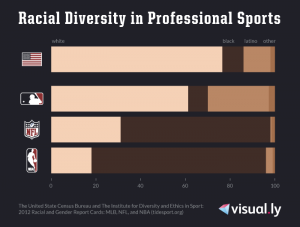WNBA Leads Major Sports in Gender, Racial Diversity; Baseball Mirrors Society Best
/
The WNBA received a combined grade of A+ for race and gender diversity, after earning and A+ for race and an A+ for gender in the 2013 WNBA Racial and Gender Report Card, produced by The Institute for Diversity and Ethics in Sports (TIDES) based at the University of Central Florida.
The study provides an analysis of the racial breakdown of the players and management in the league office and at the team level. It also looks at team general managers, coaching staffs and other support personnel.
Meanwhile, the Institute’s comparison of the racial breakdown of players in major league baseball, the National Football League and the National Basketball Association, als o released this month, shows that baseball has a demographic breakdown that more closely reflects the nation’s demographics. But the most diverse league – in terms of players as well as the front office – is the WNBA.
o released this month, shows that baseball has a demographic breakdown that more closely reflects the nation’s demographics. But the most diverse league – in terms of players as well as the front office – is the WNBA.
Richard Lapchick, the director of TIDES and primary author of the report, said, “The WNBA continues to set the standard for racial and gender diversity amongst all professional leagues.”
Among the key statistics compiled by TIDES highlighting the WNBA:
- At 67 percent, women held the highest percentage of assistance coaching positions in the history of the WNBA, setting a new mark for the second consecutive year.
- The percentage of people of color holding professional level staff positions in the WNBA League Office increased from 29 to 33 percent while the percentage of women increased by 8 percentage points.
- WNBA players of color increased by five percentage points in 2013.
- Nine women and seven people of color had ownership positions on a WNBA franchise in 2013. Most were limited partners.
- The number of women in the top management role increased from two to five women CEO/Presidents from 2012 to 2013.
Locally, of the 24 individuals highlighted on the Connecticut Sun website as members of the team staff, 12 are women and two are individuals of color. The CEO and VP/General Manager are men, and the head coach, Anne Donovan, is a woman.
Laurel J. Richie, t he first woman of color to become president of a professional sports league, continued the WNBA’s tradition as professional sports’ most diverse organization. Richie, a veteran marketing executive, brought more than three decades of experience in consumer marketing, corporate branding, public relations and corporate management, when she was appointed President of the WNBA, in 2011.
he first woman of color to become president of a professional sports league, continued the WNBA’s tradition as professional sports’ most diverse organization. Richie, a veteran marketing executive, brought more than three decades of experience in consumer marketing, corporate branding, public relations and corporate management, when she was appointed President of the WNBA, in 2011.
Many would argue that baseball is no longer "America's Pastime", but strikingly the racial composition of the average major league team corresponds almost perfectly to their proportions in American society, the Institute noted.“It truly is the game that looks like America the most, the other major sports leagues do not even come close,” the organization pointed out, as reflected in an Infographic on the website visually.
The WNBA Racial and Gender Report Card is the third report issued thus far in 2013 after the releases of the reports on Major League Baseball and the National Basketball Association earlier this year.





























